Circular Motion
Is this pawn accelerating?
- Yes
- No
- Not so sure
Now let's consider an object moving with the same speed along the circular path.
At any given point, the velocity vector is both tangent to the circle and has the same length at all positions.
The total time that it takes for this object to go around the circle once the period, $T$.
Thus, we can say the speed (the magnitude of the velocity) is
$$v =\frac{\textrm{distance traveled}}{\textrm{time it took}}= \frac{2\pi r}{T} $$Find the speed of the moon as it orbits around the earth. The moon is on avarage 385,000 km from the earth. It take 27.3 days to complete one orbit.
Uniform Circular Motion:
If we can say that the speed of an object undergoing circular motion is not changing, then we'll call that type of motion: Uniform Circular Motion.
Some examples: planets going around the sun. (mostly circular although not quite)
A record player.
horses on the carousel (while the ride is not starting or stopping.)
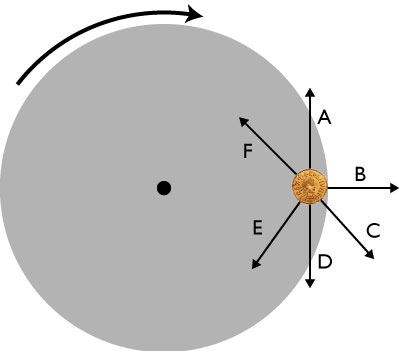
A coin sits on a rotating turntable. The direction of rotation is shown by the curved arrow above the turntable. (You are looking down on the turntable.) At the instant shown in the figure, which arrow is closest to the direction of the coin’s velocity?
Let's find $\Delta \mathbf{v}$:
$$\Delta \mathbf{v} = \mathbf{v} - \mathbf{v}_0$$Graphical subtraction would look like this:
Which vector best represents $\mathbf{v} - \mathbf{v}_0$ ?
Which vector best represents $\mathbf{v} - \mathbf{v}_0$ ?
Now we can see where the acceleration vector is pointing.
It's pointing toward the center of the circle.
With a little geometry, we could show that the magnitude of the acceleration vector will be given by:
$$ a = \frac{v^2}{r}$$.Thus, an object undergoing uniform circular motion has a 'centripetal acceleration' proportional to the speed squared and the inversely proportional to the distance from the center.
Centripetal Force
Newton's second law still holds in the case of circular motion
$$F = ma = m \frac{v^2}{r}$$We'll can any force (tension, friction, gravity, etc which is always pointed towards the center of a circular path a centripetal force.
This is not a new force, it's merely a classification of the previous forces we've already dealt with.

A ball is spun around on a string. The tension force is always directed towards the center of the circular path.
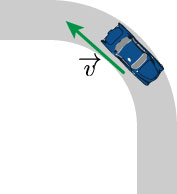
A car traveling around a curve is acted on by the static friction force.
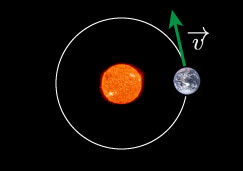
Earth around stays in orbit due to the radially directed force of gravity between the earth and the sun.
Let's spin a ball on a string far away from the earth so there is no gravity acting on the ball. Thus the only force is present is the tension from the rope. $$\sum F_r = T$$
Putting this into Newton's second law, we'll have: $$T = m a_\textrm{cent} = m\frac{v^2}{r}$$
A string will break if the tension in it is greater than 500 N. How fast can I swing a 1 kg ball using 2 meters of this string without breaking it? I'm swinging it in a horizontal plane (disregard gravity for now).
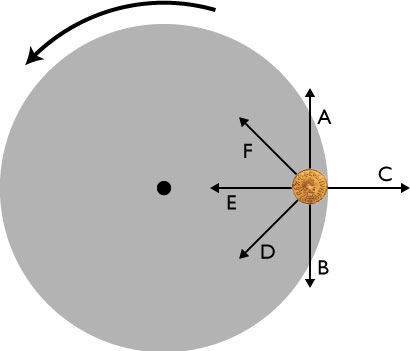
A coin sits on a rotating turntable. At the instant shown in the figure, which arrow gives the direction of the frictional force on the coin?
The static friction between the metal coin and the wood will be strong enough to keep the coin from slipping, provided the $v$ of the wooden plate doesn't get too large. Here, the only force acting the radial direction is the $f_s$. Thus:
$$\sum F = f_s = m \frac{v^2}{r}$$What’s the maximum speed my 200 kg go-kart can go around a curve with radius 10m without sliding out of control? (Assume rubber tires on dry concrete.)
So far...
Objects traveling around in a circle, even with constant speed, have a centripetal acceleration, given by:
$$a_\textrm{cent} = \frac{v^2}{r}$$This is a vector, and always pointed towards the center of the circle around which the object is traveling. Also pointing towards the center of the circle is a centripetal force. This could be tension, friction, gravity, etc...
$$\mathbf{F}_\textrm{cent} = m \mathbf{a}_\textrm{cent}$$The period of an object undergoing uniform circular motion is given by:
$$T = \frac{2 \pi r}{v}$$Period
A sometimes more useful measure of the orbit of an object is its period, $T$. The period is defined as the time it takes to complete one revolution around. For example:
- The period of the moon around the earth: 27.32 days = $2.36 \times 10^6$ s
- The period of a LP record is 1.8 s (33 $\frac{1}{3}$ rot per minute)
Gravity, again
Near the surface of the Earth
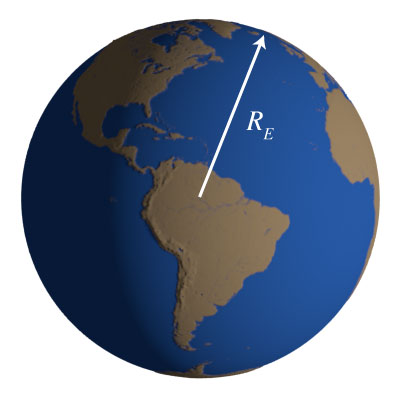
The radius of the earth is a big number. When we put it in the denominator of the force function, and square it we get really big number. $${F_\textrm{G} = G\frac{M_E m}{R_E^2}} = G \frac{M_E m}{6378000^2} = G \frac{M_E m}{40678884000000}$$ And so, when we talk about going 1 km up into the sky, we're really not changing the denominator of this equation all that much.
Compare: $$\frac{1}{6378000^2}\; \;\textrm{and} \;\; \frac{1}{6379000^2}$$ To: $$\frac{40678884000000}{40691641000000} = 0.999686$$
little g
$$F_\textrm{G} = G\frac{M_E m}{R_E^2} = \underbrace{\left( \frac{G M_E}{R_E^2}\right)}_g m = mg$$
Does little g change?

The acceleration due to gravity changes by small amounts in different locations around the earth.
| City | value of $g$ |
|---|---|
| New York City | 9.8036 |
| London | 9.81599 |
| Mexico City | 9.77628 |
| Copenhagen | 9.82057 |
The mass is not uniformly distributed: Some parts of the earth are denser than other parts. This leads to more mass underneath and a higher g value.

The earth is not a perfect sphere: The earth is a little wider than it is tall. Thus, if you're on the equator, you're a little bit further away from the center than if you're at the pole.
The earth is rotating: centripetal accelerations exist for objects on rotating surfaces.
Orbits
In the case of an orbiting body, i.e. a planet around the sun, or a moon around a planet, or a satellite around the earth, the only force acting is the centrally directed gravitational attraction between the two bodies.
$$\sum F = F_\textrm{grav} = G \frac{m_1 m_2}{r^2}$$Using the second law, we can write:
$$F = G \frac{m_1 m_2}{r^2} = m_2a = m_2 \frac{v^2}{r}$$Now we can predict some universal behaviors of orbiting objects.
For example, for an object orbiting the earth, we can write:
$$G \frac{M_E m}{r^2} = m \frac{v^2}{r}$$We can solve this for $v$, the speed of the orbiting object:
$$ v= \sqrt{\frac{G M_E}{r}}$$This gives the speed of an object for a given orbital distance.
!!!Notice that there is no $m$ in this equation!!!
Now we can use the gravitational force to calculate the expected period:
$$v = \sqrt{\frac{G M_e}{r}} = \frac{2 \pi r}{T}$$which can be solved for $T$:
$$T = \frac{2\pi r^{3/2}}{\sqrt{G M_E}}$$
Kepler figured out a version of this relationship before Newton: $$T \propto r^{3/2}$$ The period is proportional to the three-halfs power of the orbital radius.

Kepler's Laws of Planetary Motion
1. The orbit of a planet is an ellipse with the Sun at one of the two foci.
2. A line segment joining a planet and the Sun sweeps out equal areas during equal intervals of time
3. The square of the period is proportional to the cube of the radius
Kepler's Harmony of the World
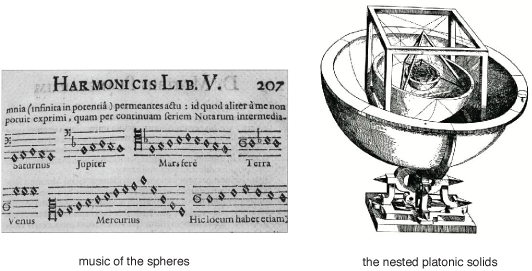
Satellites in Orbit
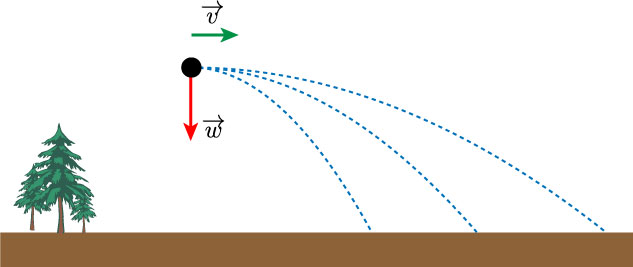
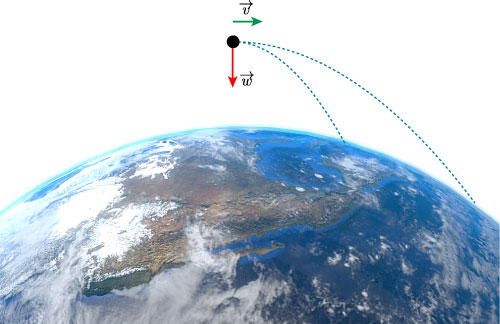

Thus, putting an object into orbit just requires a fast enough initial velocity in the right direction.

What about the force vectors?
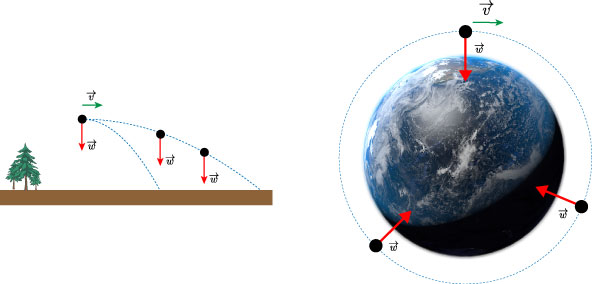
Near the surface of the earth we assumed the vectors were always point 'down'. However when we look at the earth as sphere, we see that the force vectors for the weight of an object actually point towards the center of the earth.
How fast will an object need to travel to orbit the earth at its surface?
A very special orbit
There will be an orbital distance where the period of the orbiting satellite exactly matches the rotation of the earth.
List of geosynchronous satellitesFind the position/radius for a geosynchronous orbit around the earth.

The radius of Columbus Circle is 0.025 miles (1/40th of a mile). If you want to drive around it in 5 seconds (1/720 hours). How fast should you be going?
Here is a ball being swung in a vertical circle. Among the points listed, where is the tension in the string the greatest?
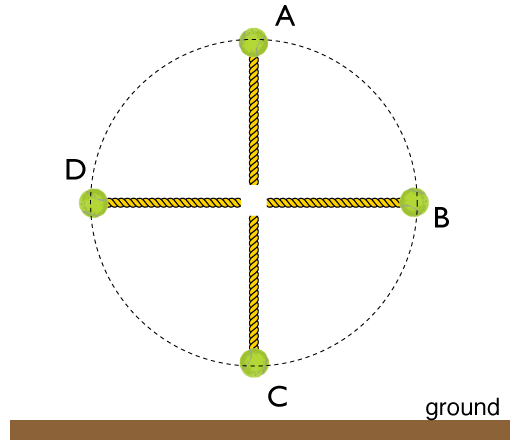
What is the normal force acting on the mass $m$ if the tray is being accelerated in the direction of +y with a magnitude of...?
Normal Forces
Swinging Scales

A space station is designed in the shape of a large, hollow ring that is uniformly rotating. The outer diameter of the station is 300 m. With what period must the station rotate so that a person sitting on the outer wall experiences “a moon like gravitational feel".
Which of the vectors best shows the net acceleration of the ball at the location shown?
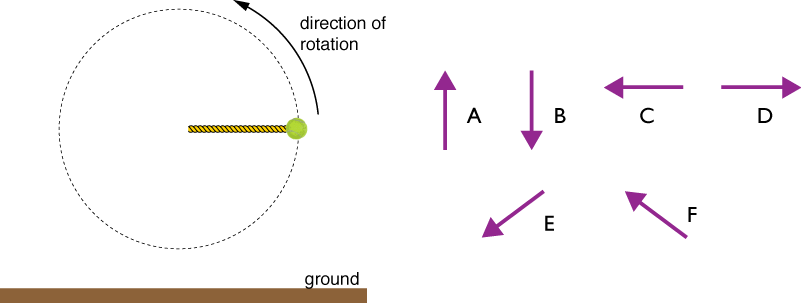
At the position labeled $A$, what is the minimum speed the ball can have while still keeping some tension on the rope? (i.e how fast to ensure tension cannot be zero)
